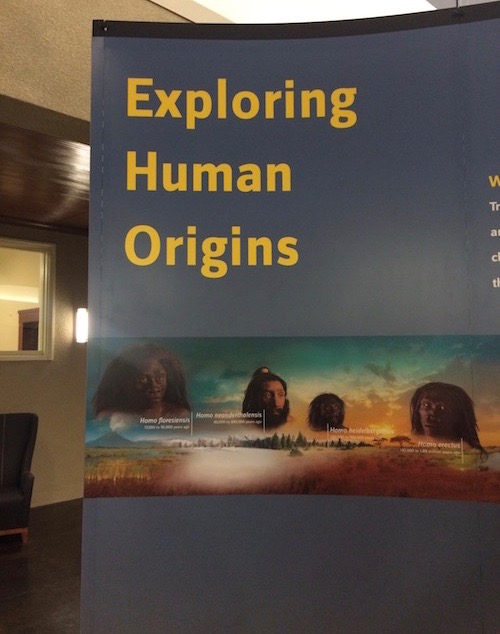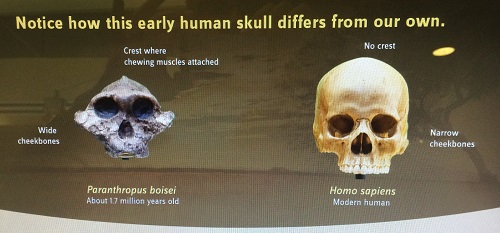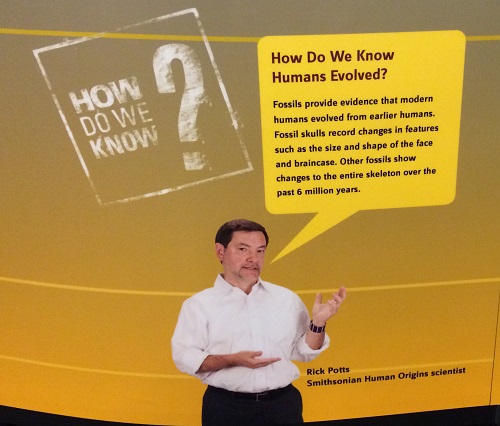 Evolution
Evolution
 Human Origins
Human Origins
Smithsonian’s Traveling Human Origins Exhibit Overstates the Case for Human Evolution

On Tuesday I was at the Milpitas Public Library in Milpitas, California, to hear a presentation by paleoanthropologist Rick Potts. Dr. Potts was on hand because a traveling exhibit he curated is on view at the library. It’s sort of a portable version of the Smithsonian’s Hall of Human Origins. Obviously this traveling exhibit is much smaller than the permanent one at the National Museum of Natural History in Washington, D.C. (I wrote about that here.) Yet it manages to retain many of the same flaws.
The exhibit is titled “Exploring Human Origins: What Does It Mean to Be Human?” It’s currently making a circuit around the country, visiting 19 public libraries from Spokane, Washington, to Bangor, Maine.

First and foremost, the traveling exhibit is absolutely 100 percent pro-Darwin and gives no discussion whatsoever to non-Darwinian views of human origins. There are the usual overstatements and crucial omissions about the evidence. For example:
- Like the permanent exhibit, the traveling version calls species like Australopithecus africanus or Paranthropus boisei “early humans,” even though these species were not human-like at all and in the latter case, are thought to be far removed from the human line. These grossly misleading statements are, of course, designed to make people think that we’re related to very non-human-like forms.
- The traveling exhibit states that Australopithecus sediba could be a human “ancestor” even though the consensus view is that it lived after the appearance of Homo, and thus cannot be our ancestor. It also had the wrong anatomy to be our ancestor. Yes, the exhibit qualifies its statement with a question mark, asking, “A new ancestor for us all?” But it never explains that the answer to the question is clearly no.
- The exhibit completely fails to acknowledge the distinct break in the fossil record between the ape-like members of Australopithecus and the very human-like members of our genus Homo. To learn about this crucial gap in the hominid fossil record, you have to turn to obscure writings in technical journals — it’s essentially never admitted in museum exhibits designed for the public. But we’ve covered this break here at Evolution News; see “A Big Bang Theory of Homo.”
- And unsurprisingly there are no mentions of the population genetics problems with Darwinian explanations of human origins. As biologist Ann Gauger explains here and here, the mathematics of population genetics basically refutes unguided models of human evolution because there is drastically insufficient time allowed by the fossil record for multimutation features to arise since our supposed most recent common ancestor with apes 6 to 10 million years ago. Although this problem has been documented in the peer-reviewed literature, the exhibit expresses zero interest in exploring this crucial mathematical barrier to unguided models of human origins.
The exhibit claims to seek only to start a “conversation” with the public about human origins. But guess which views are allowed in that “conversation”? That’s right: Only those that support Darwinian evolution and shared ancestry between humans and non-humans.
If there’s any question about this agenda, consider the words of Dr. Potts himself, director of the Smithsonian’s Human Origins Program and curator of anthropology at the National Museum of Natural History.

As you walk into the exhibit, one of the displays asks the question, “How Do We Know Humans Evolved?” It shows a photo of Potts answering:
Fossils provide evidence that modern humans evolved from earlier humans. Fossil skulls record changes in features such as the size and shape of the braincase. Other fossils show changes to the entire skeleton over the past six million years.
There’s no mention of the fact that main members of the genus Homo have brain sizes within the range of modern human genetic variation, nor is there any acknowledgement that larger brain sizes in Homo appear in an abrupt, punctuated manner that contradicts what we’d expect from Darwinian gradualism. Indeed, our entire genus Homo appears abruptly, but there’s no mention of that either.
In his talk, Rick Potts brooked no dissent on human-ape common ancestry. He discussed the high degree of genetic similarities between humans and chimps:
Part of the subject of human evolution introduces this idea that there is a kinship among all creatures on the face of the earth. All living creatures past and present, and human beings are part of that too. And that has been borne out by genetics. This connectedness among all species is not something that everyone embraces or accepts for a variety of reasons. But it’s been scientifically shown time and time again that this genetic relationship holds up and connects us with all other species.
Apparently that’s the kind of “conversation” Potts wants to spark: to make skeptics of common descent feel like they are opposing science and standing in the way of well-established rational knowledge. But as is typical, Potts overstates the degree of human-chimp genetic similarity. Realistic assessments looking at non-coding DNA, insertions, deletions, and other differences show that our DNA might be less than 85 percent genetically similar to chimps’.
And he disregards the obvious possibility of common design. Designers, after all, regularly re-use blueprints in different designs. Genetic similarities between humans and chimps could easily point to common design over common descent.
And never mind that conflicting phylogenetic trees yielded by the DNA evidence have prompted quite a few leading scientists to abandon the idea that there is a “tree of life” at all, while some even question the hypothesis of common ancestry.
After the talk, the docents handed out a survey that asked people about their views “prior” to visiting the human origins exhibit. The possible responses were as follows:
- Humans have existed in their present form since the beginning of time.
- Humans have evolved over time due to natural processes such as natural selection.
- Humans have evolved over time; a supreme being guided this evolution process for the purpose of creating humans in the form they exist today.
- Other (please specify): _________________________________.
- I’m not sure / I was open to multiple views on human evolution.
Unfortunately, aside from “Other,” none of these responses would apply to people like me who accept an old earth (and don’t believe humans existed at “the beginning of time”) but who also doubt Darwinian evolution as a sufficient explanation of life’s history and don’t think an evolutionary process (whether guided or not) created humanity. This perpetuates the false dichotomy promoted by many pro-Darwin activists that your choice is either young earth creationism or some evolutionary view.
The questions on the survey are helpful, though, in making clear what the Smithsonian wants. This U.S. government-administered museum seeks to use its exhibits to convert the skeptical public to an orthodox Darwinian perspective. Naturally, therefore, it wants to assess the effectiveness of those exhibits in achieving the goal.
Want to learn more? For resources that help clarify the facts, please see:
- Science and Human Origins, by Ann Gauger, Douglas Axe, and Casey Luskin
- “Does Genome Evidence Support Human-Ape Common Ancestry?“
- “The Real Barrier to Unguided Human Evolution“
- “Waiting for Mutations: Why Darwinism Won’t Work“
- “Why We Don’t Look Like Chimps“
- “The myth of 1% human-chimp genetic differences“
- “Critically Analyzing the Argument from Human/Chimpanzee Genetic Similarity“
- “Human/Ape Common Ancestry: Following the Evidence“
- “The Mismeasure of Man: Why Popular Ideas about Human-Chimp Comparisons Are Misleading or Wrong“
- “Human Origins and the Fossil Record: What Does the Evidence Say?“
- “The Fragmented Field of Paleoanthropology“
- “The Fragmented Fossil Record of Early Hominins“
- “Later Hominins: The Australopithecine Gap“
- “A Big Bang Theory of Homo“
- “The Genus Homo: All in the Family“
This extremely biased presentation is, as I said, full of errors and omissions. It may be headed to a public library near you.
